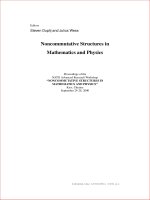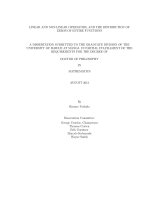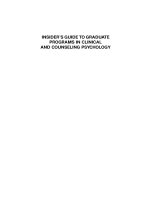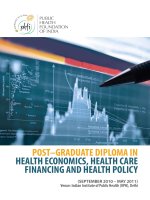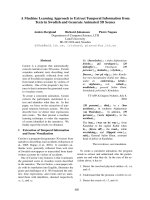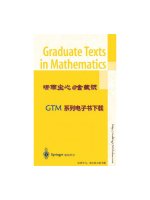Probability and stochastics (graduate texts in mathematics, 261)
Bạn đang xem bản rút gọn của tài liệu. Xem và tải ngay bản đầy đủ của tài liệu tại đây (4.26 MB, 572 trang )
www.pdfgrip.com
Graduate Texts in Mathematics
261
Editorial Board
S. Axler
K.A. Ribet
For other titles in this series, go to
/>
www.pdfgrip.com
www.pdfgrip.com
Erhan C¸ınlar
Probability and Stochastics
ABC
www.pdfgrip.com
Erhan C¸ınlar
Princeton University
328 Sherrerd Hall
Princeton, NJ 08544
USA
Editorial Board:
S. Axler
San Francisco State University
Mathematics Department
San Francisco, CA 94132
USA
K. A. Ribet
University of California at Berkeley
Mathematics Department
Berkeley, CA 94720
USA
ISSN 0072-5285
ISBN 978-0-387-87858-4
e-ISBN 978-0-387-87859-1
DOI 10.1007/978-0-387-87859-1
Springer New York Dordrecht Heidelberg London
Library of Congress Control Number: 2011921929
Mathematics Subject Classification (2010): 60
c Springer Science+Business Media, LLC 2011
All rights reserved. This work may not be translated or copied in whole or in part without the written
permission of the publisher (Springer Science+Business Media, LLC, 233 Spring Street, New York,
NY 10013, USA), except for brief excerpts in connection with reviews or scholarly analysis. Use in
connection with any form of information storage and retrieval, electronic adaptation, computer software,
or by similar or dissimilar methodology now known or hereafter developed is forbidden.
The use in this publication of trade names, trademarks, service marks, and similar terms, even if they are
not identified as such, is not to be taken as an expression of opinion as to whether or not they are subject
to proprietary rights.
Printed on acid-free paper
Springer is part of Springer Science+Business Media (www.springer.com)
www.pdfgrip.com
Preface
This is an introduction to the modern theory of probability and stochastic processes. The aim is to enable the student to have access to the many
excellent research monographs in the literature. It might be regarded as an
updated version of the textbooks by Breiman, Chung, and Neveu, just to
name three.
The book is based on the lecture notes for a two-semester course which I
have offered for many years. The course is fairly popular and attracts graduate students in engineering, economics, physics, and mathematics, and a
few overachieving undergraduates. Most of the students had familiarity with
elementary probability, but it was safer to introduce each concept carefully
and in a uniform style.
As Martin Barlow put it once, mathematics attracts us because the need
to memorize is minimal. So, only the more fundamental facts are labeled as
theorems; they are worth memorizing. Most other results are put as propositions, comments, or exercises. Also put as exercises are results that can be
understood only by doing the tedious work necessary. I believe in the Chinese
proverb: I hear, I forget; I see, I remember; I do, I know.
I have been considerate: I do not assume that the reader will go through
the book line by line from the beginning to the end. Some things are recalled or re-introduced when they are needed. In each chapter or section, the
essential material is put first, technical material is put toward the end. Subheadings are used to introduce the subjects and results; the reader should
have a quick overview by flipping the pages and reading the headings.
The style and coverage is geared toward the theory of stochastic processes,
but with some attention to the applications. The reader will find many instances where the gist of the problem is introduced in practical, everyday
language, and then is made precise in mathematical form. Conversely, many
a theoretical point is re-stated in heuristic terms in order to develop the
intuition and to provide some experience in stochastic modeling.
The first four chapters are on the classical probability theory: random
variables, expectations, conditional expectations, independence, and the classical limit theorems. This is more or less the minimum required in a course
at graduate level probability. There follow chapters on martingales, Poisson
random measures, L´evy processes, Brownian motion, and Markov processes.
v
www.pdfgrip.com
vi
Preface
The first chapter is a review of measure and integration. The treatment
is in tune with the modern literature on probability and stochastic processes. The second chapter introduces probability spaces as special measure
spaces, but with an entirely different emotional effect; sigma-algebras are
equated to bodies of information, and measurability to determinability by
the given information. Chapter III is on convergence; it is routinely classical; it goes through the definitions of different modes of convergence, their
connections to each other, and the classical limit theorems. Chapter IV is
on conditional expectations as estimates given some information, as projection operators, and as Radon-Nikodym derivatives. Also in this chapter is
the construction of probability spaces using conditional probabilities as the
initial data.
Martingales are introduced in Chapter V in the form initiated by P.-A.
Meyer, except that the treatment of continuous martingales seems to contain
an improvement, achieved through the introduction of a “Doob martingale”,
a stopped martingale that is uniformly integrable. Also in this chapter are two
great theorems: martingale characterization of Brownian motion due to L´evy
and the martingale characterization of Poisson process due to Watanabe.
Poisson random measures are developed in Chapter VI with some care.
The treatment is from the point of view of their uses in the study of point
processes, discontinuous martingales, Markov processes with jumps, and, especially, of L´evy processes. As the modern theory pays more attention to
processes with jumps, this chapter should fulfill an important need. Various
uses of them occur in the remaining three chapters.
Chapter VII is on L´evy processes. They are treated as additive processes
just as L´evy and Itˆo thought of them. Itˆ
o-L´evy decomposition is presented
fully, by following Itˆ
o’s method, thus laying bare the roles of Brownian motion
and Poisson random measures in the structure of L´evy processes and, with a
little extra thought, the structure of most Markov processes. Subordination
of processes and the hitting times of subordinators are given extra attention.
Chapter VIII on Brownian motion is mostly on the standard material:
hitting times, the maximum process, local times, and excursions. Poisson
random measures are used to clarify the structure of local times and Itˆ
o’s
characterization of excursions. Also, Bessel processes and some other Markov
processes related to Brownian motion are introduced; they help explain the
recurrence properties of Brownian motion, and they become examples for the
Markov processes to be introduced in the last chapter.
Chapter IX is the last, on Markov processes. Itˆ
o diffusions and jumpdiffusions are introduced via stochastic integral equations, thus displaying the
process as an integral path in a field of L´evy processes. For such processes, we
derive the classical relationships between martingales, generators, resolvents,
and transition functions, thus introducing the analytic theory of them. Then
we re-introduce Markov processes in the modern setting and explain, for Hunt
processes, the meaning and implications of the strong Markov property and
quasi-left-continuity.
www.pdfgrip.com
Preface
vii
Over the years, I have acquired indebtedness to many students for their
enthusiastic search for errors in the manuscript. In particular, Semih Sezer
and Yury Polyanskiy were helpful with corrections and improved proofs. The
manuscript was formatted by Emmanuel Sharef in his junior year, and Willie
Wong typed the first six chapters during his junior and senior years. SiuTang Leung typed the seventh chapter, free of charge, out of sheer kindness.
Evan Papageorgiou prepared the figures on Brownian motion and managed
the latex files for me. Finally, Springer has shown much patience as I missed
deadline after deadline, and the staff there did an excellent job with the
production. Many thanks to all.
www.pdfgrip.com
www.pdfgrip.com
Frequently Used
Notation
N = {0, 1, . . .}, N = {0, 1, . . . , +∞}, N∗ = {1, 2, . . .}.
R = (−∞, +∞), R = [−∞, +∞], R+ = [0, ∞), R+ = [0, +∞].
(a, b) is the open interval with endpoints a and b; the closed version is
[a, b]; the left-open right-closed version is (a, b].
exp x = ex , exp− x = e−x , Leb is the Lebesgue measure.
Rd is the d-dimensional Euclidean space, for x and y in it,
√
x · y = x1 y1 + · · · + xd yd , |x| = x · x .
(E, E) denotes a measurable space, E is also the set of all E-measurable
functions from E into R, and E+ is the set of positive functions in E.
1A (x) = δx (A) = I(x, A) is equal to 1 if x ∈ A and to 0 otherwise.
BE is the Borel σ-algebra on E when E is topological.
C(E → F ) is the set of all continuous functions from E into F .
2
C2K = CK
(Rd → R) is the set of twice continuously differentiable functions,
from Rd into R, with compact support.
E(X|G) is the conditional expectation of X given the σ-algebra G.
Et X = E(X|Ft ) when the filtration (Ft ) is held fixed.
ix
www.pdfgrip.com
www.pdfgrip.com
Contents
Preface
v
Frequently Used Notation
I
ix
Measure and Integration
1
Measurable Spaces . . . . . . . . .
2
Measurable Functions . . . . . . .
3
Measures . . . . . . . . . . . . . .
4
Integration . . . . . . . . . . . . .
5
Transforms and Indefinite Integrals
6
Kernels and Product Spaces . . . .
.
.
.
.
.
.
.
.
.
.
.
.
.
.
.
.
.
.
.
.
.
.
.
.
.
.
.
.
.
.
.
.
.
.
.
.
.
.
.
.
.
.
.
.
.
.
.
.
.
.
.
.
.
.
.
.
.
.
.
.
.
.
.
.
.
.
.
.
.
.
.
.
1
1
6
14
19
29
37
II Probability Spaces
1
Probability Spaces and Random Variables
2
Expectations . . . . . . . . . . . . . . . .
3
Lp -spaces and Uniform Integrability . . .
4
Information and Determinability . . . . .
5
Independence . . . . . . . . . . . . . . . .
.
.
.
.
.
.
.
.
.
.
.
.
.
.
.
.
.
.
.
.
.
.
.
.
.
.
.
.
.
.
.
.
.
.
.
.
.
.
.
.
.
.
.
.
.
.
.
.
.
.
.
.
.
.
.
49
50
57
70
75
82
III Convergence
1
Convergence of Real Sequences
2
Almost Sure Convergence . . .
3
Convergence in Probability . .
4
Convergence in Lp . . . . . . .
5
Weak Convergence . . . . . . .
6
Laws of Large Numbers . . . .
7
Convergence of Series . . . . .
8
Central Limits . . . . . . . . .
.
.
.
.
.
.
.
.
.
.
.
.
.
.
.
.
.
.
.
.
.
.
.
.
.
.
.
.
.
.
.
.
.
.
.
.
.
.
.
.
.
.
.
.
.
.
.
.
.
.
.
.
.
.
.
.
.
.
.
.
.
.
.
.
.
.
.
.
.
.
.
.
.
.
.
.
.
.
.
.
.
.
.
.
.
.
.
.
93
93
97
101
105
109
118
124
127
IV Conditioning
1
Conditional Expectations . . . . . . . . . .
2
Conditional Probabilities and Distributions
3
Conditional Independence . . . . . . . . . .
4
Construction of Probability Spaces . . . . .
5
Special Constructions . . . . . . . . . . . .
.
.
.
.
.
.
.
.
.
.
.
.
.
.
.
.
.
.
.
.
.
.
.
.
.
.
.
.
.
.
.
.
.
.
.
.
.
.
.
.
.
.
.
.
.
.
.
.
.
.
139
139
149
158
160
166
.
.
.
.
.
.
.
.
.
.
.
.
.
.
.
.
.
.
.
.
.
.
.
.
.
.
.
.
.
.
.
.
.
.
.
.
.
.
.
.
.
.
.
.
.
.
.
.
.
.
.
.
.
.
.
.
.
.
.
.
.
.
.
.
.
.
xi
www.pdfgrip.com
xii
Contents
V Martingales and Stochastics
1
Filtrations and Stopping Times . . . . . . . . . . . . .
2
Martingales . . . . . . . . . . . . . . . . . . . . . . . .
3
Martingale Transformations and Maxima . . . . . . .
4
Martingale Convergence . . . . . . . . . . . . . . . . .
5
Martingales in Continuous Time . . . . . . . . . . . .
6
Martingale Characterizations for Wiener and Poisson .
7
Standard Filtrations and Modifications of Martingales
.
.
.
.
.
.
.
.
.
.
.
.
.
.
.
.
.
.
.
.
.
.
.
.
.
.
.
.
171
171
181
190
199
213
225
234
VI Poisson Random Measures
1
Random Measures . . . . . . . . . . . . . . . .
2
Poisson Random Measures . . . . . . . . . . . .
3
Transformations . . . . . . . . . . . . . . . . .
4
Additive Random Measures and L´evy Processes
5
Poisson Processes . . . . . . . . . . . . . . . . .
6
Poisson Integrals and Self-exciting Processes . .
.
.
.
.
.
.
.
.
.
.
.
.
.
.
.
.
.
.
.
.
.
.
.
.
.
.
.
.
.
.
.
.
.
.
.
.
.
.
.
.
.
.
.
.
.
.
.
.
243
243
248
263
277
290
298
VII L´
evy Processes
1
Introduction . . . . . . . . . . . . . . . . .
2
Stable Processes . . . . . . . . . . . . . .
3
L´evy Processes on Standard Settings . . .
4
Characterizations for Wiener and Poisson
5
Itˆ
o-L´evy Decomposition . . . . . . . . . .
6
Subordination . . . . . . . . . . . . . . . .
7
Increasing L´evy Processes . . . . . . . . .
.
.
.
.
.
.
.
.
.
.
.
.
.
.
.
.
.
.
.
.
.
.
.
.
.
.
.
.
.
.
.
.
.
.
.
.
.
.
.
.
.
.
.
.
.
.
.
.
.
.
.
.
.
.
.
.
.
.
.
.
.
.
.
.
.
.
.
.
.
.
.
.
.
.
.
.
.
313
313
329
340
349
354
360
368
VIII Brownian Motion
1
Introduction . . . . . . . . . . . . . . .
2
Hitting Times and Recurrence Times .
3
Hitting Times and Running Maximum
4
Wiener and its Maximum . . . . . . .
5
Zeros, Local Times . . . . . . . . . . .
6
Excursions . . . . . . . . . . . . . . . .
7
Path Properties . . . . . . . . . . . . .
8
Existence . . . . . . . . . . . . . . . .
.
.
.
.
.
.
.
.
.
.
.
.
.
.
.
.
.
.
.
.
.
.
.
.
.
.
.
.
.
.
.
.
.
.
.
.
.
.
.
.
.
.
.
.
.
.
.
.
.
.
.
.
.
.
.
.
.
.
.
.
.
.
.
.
.
.
.
.
.
.
.
.
.
.
.
.
.
.
.
.
.
.
.
.
.
.
.
.
.
.
.
.
.
.
.
.
.
.
.
.
.
.
.
.
379
379
389
396
399
408
413
426
437
IX Markov Processes
1
Markov Property . . . . . . . . . .
2
Itˆ
o Diffusions . . . . . . . . . . . .
3
Jump-Diffusions . . . . . . . . . .
4
Markov Systems . . . . . . . . . .
5
Hunt Processes . . . . . . . . . . .
6
Potentials and Excessive Functions
7
Appendix: Stochastic Integration .
.
.
.
.
.
.
.
.
.
.
.
.
.
.
.
.
.
.
.
.
.
.
.
.
.
.
.
.
.
.
.
.
.
.
.
.
.
.
.
.
.
.
.
.
.
.
.
.
.
.
.
.
.
.
.
.
.
.
.
.
.
.
.
.
.
.
.
.
.
.
.
.
.
.
.
.
.
.
.
.
.
.
.
.
.
.
.
.
.
.
.
443
444
455
473
498
505
518
525
.
.
.
.
.
.
.
.
.
.
.
.
.
.
www.pdfgrip.com
Contents
xiii
Notes and Comments
533
Bibliography
541
Index
551
www.pdfgrip.com
www.pdfgrip.com
Chapter I
Measure and Integration
This chapter is devoted to the basic notions of measurable spaces,
measure, and integration. The coverage is limited to what probability theory
requires as the entrance fee from its students. The presentation is in the
form and style attuned to the modern treatments of probability theory and
stochastic processes.
1
Measurable Spaces
Let E be a set. We use the usual notations for operations on subsets of E:
1.1
A ∪ B,
A ∩ B,
A\B
denote, respectively, the union of A and B, the intersection of A and B,
and the complement of B in A. In particular, E \ B is called simply the
complement of B and is also denoted by B c . We write A ⊂ B or B ⊃ A to
mean that A is a subset of B, that is, A is contained in B, or equivalently,
B contains A. Note that A = B if and only if A ⊂ B and A ⊃ B. For an
arbitrary collection {Ai : i ∈ I} of subsets of E, we write
1.2
Ai ,
i∈I
Ai
i∈I
for the union and intersection, respectively, of all the sets Ai , i ∈ I.
The empty set is denoted by ∅. Sets A and B are said to be disjoint if
A ∩ B = ∅. A collection of sets is said to be disjointed if its every element
is disjoint from every other. A countable disjointed collection of sets whose
union is A is called a partition of A.
A collection C of subsets of E is said to be closed under intersections if
A ∩ B belongs to C whenever A and B belong to C. Of course, then, the
E. C
¸ ınlar, Probability and Stochastics, Graduate Texts
in Mathematics 261, DOI 10.1007/978-0-387-87859-1 1,
c Springer Science+Business Media, LLC 2011
1
www.pdfgrip.com
2
Measure and Integration
Chap. 1
intersection of every non-empty finite collection of sets in C is in C. If the
intersection of every countable collection of sets in C is in C, then we say that
C is closed under countable intersections. The notions of being closed under
complements, unions, and countable unions, etc. are defined similarly.
Sigma-algebras
A non-empty collection E of subsets of E is called an algebra on E provided
that it be closed under finite unions and complements. It is called a σ-algebra
on E if it is closed under complements and countable unions, that is, if
1.3
a)
b)
A ∈ E ⇒ E \ A ∈ E,
A1 , A2 , . . . ∈ E ⇒
n An ∈ E.
Since the intersection of a collection of sets is the complement of the union
of the complements of those sets, a σ-algebra is also closed under countable
intersections.
Every σ-algebra on E includes E and ∅ at least. Indeed, E = {∅, E} is
the simplest σ-algebra on E; it is called the trivial σ-algebra. The largest
is the collection of all subsets of E, usually denoted by 2E ; it is called the
discrete σ-algebra on E.
The intersection of an arbitrary (countable or uncountable) family of
σ-algebras on E is again a σ-algebra on E. Given an arbitrary collection
C of subsets of E, consider all the σ-algebras that contain C (there is at least
one such σ-algebra, namely 2E ); take the intersection of all those σ-algebras;
the result is the smallest σ-algebra that contains C; it is called the σ-algebra
generated by C and is denoted by σC.
If E is a topological space, then the σ-algebra generated by the collection
of all open subsets of E is called the Borel σ-algebra on E; it is denoted byBE
or B(E); its elements are called Borel sets.
p-systems and d-systems
A collection C of subsets of E is called a p-system if it is closed under
intersections; here, p is for product, the latter being an alternative term for
intersection, and next, d is for Dynkin who introduced these systems into
probability. A collection D of subsets of E is called a d-system on E if
1.4
a)
b)
c)
E ∈ D,
A, B ∈ D and A ⊃ B ⇒ A \ B ∈ D,
A ⇒ A ∈ D.
(An ) ⊂ D and An
In the last line, we wrote (An ) ⊂ D to mean that (An ) is a sequence of
elements of D and we wrote An
A to mean that the sequence is increasing
with limit A in the following sense:
1.5
A1 ⊂ A2 ⊂ . . . ,
∪n An = A.
www.pdfgrip.com
Sec. 1
Measurable Spaces
3
It is obvious that a σ-algebra is both a p-system and a d-system, and the
converse will be shown next. Thus, p-systems and d-systems are primitive
structures whose superpositions yield σ-algebras.
1.6 Proposition. A collection of subsets of E is a σ-algebra if and only
if it is both a p-system and a d-system on E.
Proof. Necessity is obvious. To show the sufficiency, let E be a collection
of subsets of E that is both a p-system and a d-system. First, E is closed
under complements: A ∈ E ⇒ E \ A ∈ E, since E ∈ E and A ⊂ E and E is a
d-system. Second, it is closed under unions: A, B ∈ E ⇒ A ∪ B ∈ E, because
A ∪ B = (Ac ∩ B c )c and E is closed under complements (as shown) and under
intersections by the hypothesis that it is a p-system. Finally, this closure
extends to countable unions: if (An ) ⊂ E, then B1 = A1 and B2 = A1 ∪ A2
and so on belong to E by the preceding step, and Bn
n An , which together
imply that n An ∈ E since E is a d-system by hypothesis.
The lemma next is in preparation for the main theorem of this section.
Its proof is left as an exercise in checking the conditions 1.4 one by one.
1.7
Lemma. Let D be a d-system on E. Fix D in D and let
ˆ = {A ∈ D : A ∩ D ∈ D}
D
ˆ is again a d-system.
Then, D
Monotone class theorem
This is a very useful tool for showing that certain collections are
σ-algebras. We give it in the form found most useful in probability theory.
1.8 Theorem. If a d-system contains a p-system, then it contains also
the σ-algebra generated by that p-system.
Proof. Let C be a p-system. Let D be the smallest d-system on E that
contains C, that is, D is the intersection of all d-systems containing C. The
claim is that D ⊃ σC. To show it, since σC is the smallest σ-algebra containing
C, it is sufficient to show that D is a σ-algebra. In view of Proposition 1.6, it
is thus enough to show that the d-system D is also a p-system.
To that end, fix B in C and let
D1 = {A ∈ D : A ∩ B ∈ D}.
Since C is contained in D, the set B is in D; and Lemma 1.7 implies that D1
is a d-system. It also contains C: if A ∈ C then A ∩ B ∈ C since B is in C and
C is a p-system. Hence, D1 must contain the smallest d-system containing C,
that is, D1 ⊃ D. In other words, A ∩ B ∈ D for every A in D and B in C.
Consequently, for fixed A in D, the collection
D2 = {B ∈ D : A ∩ B ∈ D}
www.pdfgrip.com
4
Measure and Integration
Chap. 1
contains C. By Lemma 1.7, D2 is a d-system. Thus, D2 must contain D.
In other words, A ∩ B ∈ D whenever A and B are in D, that is, D is a
p-system.
Measurable spaces
A measurable space is a pair (E, E) where E is a set and E is a σ-algebra on
E. Then, the elements of E are called measurable sets. When E is topological
and E = BE , the Borel σ-algebra on E, then measurable sets are also called
Borel sets.
Products of measurable spaces
Let (E, E) and (F, F) be measurable spaces. For A ⊂ E and B ⊂ F , we
write A × B for the set of all pairs (x, y) with x in A and y in B; it is called
the product of A and B. If A ∈ E and B ∈ F, then A × B is said to be a
measurable rectangle. We let E⊗F denote the σ-algebra on E×F generated by
the collection of all measurable rectangles; it is called the product σ-algebra.
The measurable space (E × F, E ⊗ F) is called the product of (E, E) and
(F, F), and the notation (E, E) × (F, F) is used as well.
Exercises
1.9 Partition generated σ-algebras.
a) Let C = {A, B, C} be a partition of E. List the elements of σC.
b) Let C be a (countable) partition of E. Show that every element of
σC is a countable union of elements taken from C. Hint: Let E be the collection
of all sets that are countable unions of elements taken from C. Show that E
is a σ-algebra, and argue that E = σC.
c) Let E = R, the set of all real numbers. Let C be the collection of
all singleton subsets of R, that is, each element of C is a set that consists of
exactly one point in R. Show that every element of σC is either a countable
set or the complement of a countable set. Incidentally, σC is much smaller
than B(R); for instance, the interval (0, 1) belongs to the latter but not to
the former.
1.10 Comparisons. Let C and D be two collections of subsets of E. Show the
following:
a) If C ⊂ D then σC ⊂ σD
b) If C ⊂ σD then σC ⊂ σD
c) If C ⊂ σD and D ⊂ σC, then σC = σD
d) If C ⊂ D ⊂ σC, then σC = σD
1.11 Borel σ-algebra on R. Every open subset of R = (−∞, +∞), the real
line, is a countable union of open intervals. Use this fact to show that BR is
generated by the collection of all open intervals.
www.pdfgrip.com
Sec. 1
Measurable Spaces
5
1.12 Continuation. Show that every interval of R is a Borel set. In particular,
(−∞, x), (−∞, x], (x, y], [x, y] are all Borel sets. For each x, the singleton
{x} is a Borel set.
1.13 Continuation. Show that BR is also generated by any one of the following
(and many others):
a) The collection of all intervals of the form (−∞, x].
b) The collection of all intervals of the form (x, y].
c) The collection of all intervals of the form [x, y].
d) The collection of all intervals of the form (x, ∞).
Moreover, in each case, x and y can be limited to be rationals.
1.14 Lemma 1.7. Prove.
1.15 Trace spaces. Let (E, E) be a measurable space. Fix D ⊂ E and let
D = E ∩ D = {A ∩ D : A ∈ E}.
Show that D is a σ-algebra on D. It is called the trace of E on D, and (D, D)
is called the trace of (E, E) on D.
1.16 Single point extensions. Let (E, E) be a measurable space, and let Δ be
¯ = E ∪ {Δ}. Show that
an extra point, not in E. Let E
¯ = E ∪ {A ∪ {Δ} : A ∈ E}
E
¯ it is the σ-algebra on E¯ generated by E.
is a σ-algebra on E;
1.17 Product spaces. Let (E, E) and (F, F) be measurable spaces. Show that
ˆ ∪ F,
ˆ where
the product σ-algebra E ⊗ F is also the σ-algebra generated by E
ˆ = {A × F : A ∈ E},
E
ˆ = {E × B : B ∈ F}.
F
1.18 Unions of σ-algebras. Let E1 and E2 be σ-algebras on the same set E.
Their union is not a σ-algebra, except in some special cases. The σ-algebra
generated by E1 ∪E2 is denoted by E1 ∨E2 . More generally, if Ei is a σ-algebra
on E for each i in some (countable or uncountable) index set I, then
EI =
Ei
i∈I
denotes the σ-algebra generated by i∈I Ei (a similar notation for intersection
is superfluous, since i∈I Ei is always a σ-algebra). Let C be the collection of
all sets A having the form
Ai
A=
i∈J
for some finite subset J of I and sets Ai in Ei , i ∈ J. Show that C contains
all Ei and therefore I Ei . Thus, C generates the σ-algebra EI . Show that C
is a p-system.
www.pdfgrip.com
6
2
Measure and Integration
Chap. 1
Measurable Functions
Let E and F be sets. A mapping or function f from E into F is a rule that
assigns an element f (x) of F to each x in E, and then we write f : E → F
to indicate it. If f (x) is an element of F for each x in E, we also write
f : x → f (x) to name the mapping involved; for example, f : x → x2 + 5 is
the function f from R into R+ satisfying f (x) = x2 + 5. Given a mapping
f : E → F and a subset B of F , the inverse image of B under f is
f −1 B = {x ∈ E : f (x) ∈ B}.
2.1
We leave the proof of the next lemma as an exercise in ordinary logic.
2.2
Lemma. Let f be a mapping from E into F . Then,
f −1 ∅ = ∅,
f −1 F = E,
f −1
f −1 Bi ,
Bi =
i
f −1 (B \ C) = (f −1 B) \ (f −1 C),
f −1
i
f −1Bi
Bi =
i
i
for all subsets B and C of F and arbitrary collections {Bi : i ∈ I} of subsets
of F .
Measurable functions
Let (E, E) and (F, F) be measurable spaces. A mapping f : E → F is
said to be measurable relative to E and F if f −1 B ∈ E for every B in F. The
following reduces the checks involved.
2.3 Proposition. In order for f : E → F to be measurable relative to E
and F, it is necessary and sufficient that, for some collection F0 that generates
F, we have f −1 B ∈ E for every B in F0 .
Proof. Necessity is trivial. To prove the sufficiency, let F0 be a collection
of subsets of F such that σF0 = F, and suppose that f −1B ∈ E for every B
in F0 . We need to show that
F1 = {B ∈ F : f −1 B ∈ E}
contains F and thus is equal to F. Since F1 ⊃ F0 by assumption, once we
show that F1 is a σ-algebra, we will have F1 = σF1 ⊃ σF0 = F as needed.
But checking that F1 is a σ-algebra is straightforward using Lemma 2.2.
Composition of functions
Let (E, E), (F, F), and (G, G) be measurable spaces. Let f be a mapping
from E into F , and g a mapping from F into G. The composition of f and
g is the mapping g ◦f from E into G defined by
2.4
g ◦f (x) = g(f (x)),
x ∈ E.
www.pdfgrip.com
Sec. 2
Measurable Functions
7
The next proposition will be recalled by the phrase “measurable functions of
measurable functions are measurable”.
2.5 Proposition. If f is measurable relative to E and F, and g relative
to F and G, then g ◦ f is measurable relative to E and G.
Proof. Let f and g be measurable. For C in G, observe that (g ◦
f )−1 C = f −1 (g −1 C). Now, g −1 C ∈ F by the measurability of g and,
hence, f −1 (g −1 C) ∈ E by the measurability of f . So, g ◦ f is measurable.
Numerical functions
¯ =
Let (E, E) be a measurable space. Recall that R = (−∞, +∞), R
¯ + = [0, +∞]. A numerical function on E is a
[−∞, +∞], R+ = [0, +∞), R
¯ or some subset of R.
¯ If all its values are in R, it is
mapping from E into R
¯ + , it is said to be positive.
said to be real-valued. If all its values are in R
A numerical function on E is said to be E-measurable if it is measurable
¯ the latter denoting the Borel σ-algebra on R
¯ as
relative to E and B(R),
usual. If E is topological and E = B(E), then E-measurable functions are
called Borel functions.
The following proposition is a corollary of Proposition 2.3 using the fact
¯ is generated by the collection of intervals [−∞, r] with r in R. No
that B(R)
proof seems needed.
¯ is E-measurable if and only if,
2.6 Proposition. A mapping f : E → R
−1
for every r in R, f [−∞, r] ∈ E.
2.7 Remarks. a) The proposition remains true if [−∞, r] is replaced
by [−∞, r) or by [r, ∞] or by (r, ∞], because the intervals [−∞, r) with r in
¯ and similarly for the other two forms.
R generate B(R)
¯
b) In the particular case f : E → F , where F is a countable subset of R,
−1
the mapping f is E-measurable if and only if f {a} = {x ∈ E : f (x) = a}
is in E for every a in F .
Positive and negative parts of a function
¯ we write a ∨ b for the maximum of a and b, and a ∧ b
For a and b in R
for the minimum. The notation extends to numerical functions naturally: for
instance, f ∨ g is the function whose value at x is f (x) ∨ g(x). Let (E, E) be
a measurable space. Let f be a numerical function on E. Then,
2.8
f + = f ∨ 0,
f − = −(f ∧ 0)
are both positive functions and f = f + − f − . The function f + is called the
positive part of f , and f − the negative part.
2.9 Proposition. The function f is E-measurable if and only if both f +
and f − are.
www.pdfgrip.com
8
Measure and Integration
Chap. 1
Proof is left as an exercise. The decomposition f = f + − f − enables
us to obtain many results for arbitrary f from the corresponding results for
positive functions.
Indicators and simple functions
Let A ⊂ E. Its indicator, denoted by 1A , is the function defined by
2.10
1
0
1A (x) =
if x ∈ A,
if x ∈
/ A.
We write simply 1 for 1E . Obviously, 1A is E-measurable if and only if A ∈ E.
A function f on E is said to be simple if it has the form
n
2.11
a i 1 Ai
f=
1
for some n in N∗ = {1, 2, . . .}, real numbers a1 , . . . , an , and measurable sets
A1 , . . . , An (belonging to the σ-algebra E). It is clear that, then, there exist
m in N∗ and distinct real numbers b1 , . . . , bm and a measurable partition
m
{B1 , . . . , Bm } of E such that f =
1 bi 1Bi ; this latter representation is
called the canonical form of the simple function f .
It is immediate from Proposition 2.6 (or Remark 2.7b) applied to the
canonical form that every simple function is E-measurable. Conversely, if f
is E-measurable, takes only finitely many values, and all those values are real
numbers, then f is a simple function. In particular, every constant is a simple
function. Finally, if f and g are simple, then so are
2.12
f + g,
f − g,
f g,
f /g,
f ∨ g,
f ∧ g,
except that in the case of f /g one should make sure that g is nowhere zero.
Limits of sequences of functions
Let (fn ) be a sequence of numerical functions on E. The functions
2.13
inf fn ,
sup fn ,
lim inf fn ,
lim sup fn
are defined on E pointwise: for instance, the first is the function whose value
at x is the infimum of the sequence of numbers fn (x). In general, limit inferior
is dominated by the limit superior. If the two are equal, that is, if
2.14
lim inf fn = lim sup fn = f,
say, then the sequence (fn ) is said to have a pointwise limit f and we write
f = lim fn or fn → f to express it.
www.pdfgrip.com
Sec. 2
Measurable Functions
9
If (fn ) is increasing, that is, if f1 ≤ f2 ≤ . . ., then lim fn exists and is
equal to sup fn . We shall write fn
f to mean that (fn ) is increasing and
has limit f . Similarly, fn
f means that (fn ) is decreasing and has limit f .
The following shows that the class of measurable functions is closed under
limits.
2.15 Theorem. Let (fn ) be a sequence of E-measurable functions. Then,
each one of the four functions in 2.13 is E-measurable. Moreover, if it exists,
lim fn is E-measurable.
Proof. We start by showing that f = sup fn is E-measurable. For every x
in E and r in R, we note that f (x) ≤ r if and only if fn (x) ≤ r for all n.
Thus, for each r in R,
f −1 [−∞, r] = {x : f (x) ≤ r} =
fn−1 [−∞, r].
{x : fn (x) ≤ r} =
n
n
The rightmost member belongs to E: for each n, the set fn−1 [−∞, r] ∈ E by
the E-measurability of fn , and E is closed under countable intersections. So,
by Proposition 2.6, f = sup fn is E-measurable.
Measurability of inf fn follows from the preceding step upon observing
that inf fn = − sup(−fn ). It is now obvious that
lim inf fn = sup inf fn ,
m n≥m
lim sup fn = inf sup fn
m n≥m
are E-measurable. If these two are equal, the common limit is the definition
of lim fn , which is E-measurable.
Approximation of measurable functions
¯ + by an increasing
We start by approximating the identity function on R
sequence of simple functions of a specific form (dyadic functions). We leave
the proof of the next lemma as an exercise; drawing dn for n = 1, 2, 3
should do.
2.16
Lemma. For each n in N∗ , let
n2n
dn (r) =
k=1
k−1
1 k−1 k (r) + n1[n,∞] (r),
2n [ 2n , 2n )
¯ +.
r∈R
¯ + , and
Then, each dn is an increasing right-continuous simple function on R
¯
dn (r) increases to r for each r in R+ as n → ∞.
The following theorem is important: it reduces many a computation about
measurable functions to a computation about simple functions followed by
limit taking.
www.pdfgrip.com
10
Measure and Integration
Chap. 1
2.17 Theorem. A positive function on E is E-measurable if and only if
it is the limit of an increasing sequence of positive simple functions.
Proof. Sufficiency is immediate from Theorem 2.15. To show the necessity
¯ + be E-measurable. We are to show that there is a sequence
part, let f : E → R
(fn ) of positive simple functions increasing to f . To that end, let (dn ) be as in
the preceding lemma and put fn = dn ◦ f . Then, for each n, the function fn
is E-measurable, since it is a measurable function of a measurable function.
Also, it is positive and takes only finitely many values, because dn is so. Thus,
each fn is positive and simple. Moreover, since dn (r) increases to r for each
¯ + as n → ∞, we have that fn (x) = dn (f (x)) increases to f (x) for each
r in R
x in E as n → ∞.
Monotone classes of functions
Let M be a collection of numerical functions on E. We write M+ for the
subcollection consisting of positive functions in M, and Mb for the subcollection of bounded functions in M.
The collection M is called a monotone class provided that it includes the
constant function 1, and Mb is a linear space over R, and M+ is closed under
increasing limits; more explicitly, M is a monotone class if
2.18
a)
b)
c)
1 ∈ M,
f, g ∈ Mb and a, b ∈ R ⇒ af + bg ∈ M,
(fn ) ⊂ M+ , fn
f ⇒ f ∈ M.
The next theorem is used often to show that a certain property holds for
all E-measurable functions. It is a version of Theorem 1.8, it is called the
monotone class theorem for functions.
2.19 Theorem. Let M be a monotone class of functions on E. Suppose,
for some p-system C generating E, that 1A ∈ M for every A in C. Then,
M includes all positive E-measurable functions and all bounded E-measurable
functions.
Proof. We start by showing that 1A ∈ M for every A in E. To this end, let
D = {A ∈ E : 1A ∈ M}.
Using the conditions 2.18, it is easy to check that D is a d-system. Since
D ⊃ C by assumption, and since C is a p-system that generates E, we must
have D ⊃ E by the monotone class theorem 1.8. So, 1A ∈ M for every A in E.
Therefore, in view of the property 2.18b, M includes all simple functions.
Let f be a positive E-measurable function. By Theorem 2.17, there exists
a sequence of positive simple functions fn increasing to f . Since each fn is in
M+ by the preceding step, the property 2.18c implies that f ∈ M.
Finally, let f be a bounded E-measurable function. Then f + and f − are
in M by the preceding step and are bounded obviously. Thus, by 2.18b, we
conclude that f = f + − f − ∈ M.


